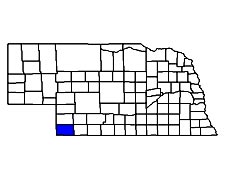
| Cicindela pulchra pulchra Say |
| Adult Length: 16 to 22 mm |
| Appearance: Adults are brilliant shiny red dorsally with greenish or bluish margins on the elytra and much blue on the head and pronotum. Maculations are minimal usually with only a dot where the base of the middle band would normally be. Many adults are completely immaculate. |
| Similar Species: This species is unlikely to be confused with any other. |
| Biology: This species occurs in short-grass prairie habitats. Preferred habitats have clayey soils and include the tops of bluffs and hills, clay flats, clay washes near chalk outcroppings, and a variety of other areas with clay soil and sparse to clumped vegetation such as bunchgrass prairie. They may occur in somewhat saline or alkaline areas. Adults are very wary and will fly long distances when alarmed. |
| Adult Life History: Adults emerge from the pupa in September and are active for a short time before overwintering. Activity resumes in spring with adults appearing in March and April. Peak numbers are found in April, May, and early June. Adults are scarce by July. It is a spring-fall species in Nebraska. |
| Larval Life History: Eggs are probably laid mostly in April and May. Most larvae reach the third instar by fall before overwintering and pupate the following summer. Larvae occur in the same habitats as the adults in clayey soils. |
| Biogeography: Though there is a record for this species from Lancaster County, Nebraska, this is probably erroneous. The only verified collection in Nebraska was from Dundy County near the tri-state marker. It may be overlooked in the state because of its typically low-density occurrence and extreme elusiveness. There is potential for it to occur in all of the westernmost panhandle counties as it is known throughout eastern Colorado and has recently been collected in the badlands region of South Dakota. In North America it occurs from southwestern Texas and eastern Arizona to southern and eastern Colorado, northern Texas, western Oklahoma and western Kansas, but its northernmost limits are still undetermined. There are two described subspecies. |


